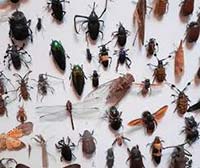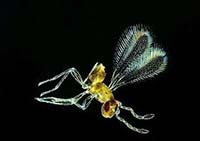
'Insectageddon' or 'Where have all the insects gone?'
Speaker: Dr Chris Hassall
Monday, 25 September 2023
 At the September u3a Todmorden meeting, our members welcomed the guest speaker Dr Chris Hassall, an Associate Professor of Animal Biology at the University of Leeds, who presented 'Insectageddon' - or 'where have all the insects gone?''
At the September u3a Todmorden meeting, our members welcomed the guest speaker Dr Chris Hassall, an Associate Professor of Animal Biology at the University of Leeds, who presented 'Insectageddon' - or 'where have all the insects gone?''
In his introduction, Chris said that we all have some sort of knowledge and experience about insects, either as a hobby, or recognising the habits of the ones we come into contact with, perhaps thinking about them as pests.
He said that Entomology, the study of insects, is a gateway to understanding, and wanting to know more about, our environment. Insects have existed for over 480 million years and have, generally, the same characteristics of each other; six legs in three pairs, two sets of wings for the ones that fly, and varying numbers and positions of legs for the ones that crawl and walk, called arthropods. There are thought to be around two hundred million tonnes, worldwide, of insects at this time. An ecologist, Sir Robert May, who was an advisor to the British Government once said that all animals were insects of a sort, with the exception of birds, which he described as a 'rounding error'.
 Insects vary wildly in terms of size, for example to contrast the Tinkerbella nana (see right), a genus of fairy wasp from Costa Rica that is so small and light that it doesn't actually fly, but swims through the air. This contrasts with the Goliath Beetle, the male of that species grows up to four and a half inches in length, and weighs in at nearly 2 ounces. Chris had studied the Damsel Fly as part of his PhD, and told us that it uses its wings like a helicopter, which helps it to scoop spiders from their web to feed on them.
Insects vary wildly in terms of size, for example to contrast the Tinkerbella nana (see right), a genus of fairy wasp from Costa Rica that is so small and light that it doesn't actually fly, but swims through the air. This contrasts with the Goliath Beetle, the male of that species grows up to four and a half inches in length, and weighs in at nearly 2 ounces. Chris had studied the Damsel Fly as part of his PhD, and told us that it uses its wings like a helicopter, which helps it to scoop spiders from their web to feed on them.
He went on to describe the benefits of insects to human beings, which include keeping pest insects in check, pollinating crops we rely on as food, and acting as sanitation experts, cleaning up waste so that the world doesn't become overrun with dung.
The knowledge and science of Entomology is thought to have been brought about by two men, both born in the eighteenth century. Gilbert White, a pioneering English naturalist who transformed the way we look at the natural world and Carl Linnaeus, a Swedish naturalist and explorer who was the first to create a uniform system for naming insects.
More recently, the science of genetics has been used to prevent insects from spreading diseases such as malaria, which has resulted in fewer deaths of humans.
But having gone through the phases of discovery and exploitation of insects, the emphasis has now switched to their conservation. Newspapers usually poles apart; the Guardian and the Daily Mail, published almost identical features pointing out the decline of insects worldwide, using terms like 'insectageddon' and 'insectapocalypse'. Chris said that this leads to the questions of why is this happening, and what can we do about it?
The 'why' question can be answered in part by things such as invasive and destructive insects and other animals and the loss of habitat due to increased farming worldwide. For example, 70% of the land of the United Kingdom is used for agriculture. This has led to trees and bushes, the natural habitat of insects, being replaced by fields, along with the effects of pesticides and fertilisers. Climate change has also played its part, with the planet getting warmer, and the increase of extreme weather events.
The actual effects of these changes on the insect population are quite difficult to establish. The data gathered indicates that some species of insects are declining, while others show an increase. A bigger problem for entomologists is where the data they use is gathered from. The most modern and efficient equipment to gather accurate information is in the developed, and rich, countries of the world. But the vast majority of the insects in the world are found in the poorer, and more remote countries – so only a fraction of the true figures of decline, or otherwise, can be established. Other slides showed some of the equipment and methods used to monitor insect numbers and obtain samples, which include hitting tree trunks and bushes, catching any insects that fall out on trays, sheets, or similar.
Chris mentioned a term perhaps unfamiliar to the audience – 'Citizen Science'. An example of this is the 'Butterfly Monitoring Scheme' which began 47 years ago in Britain. Chris described it as 'probably the greatest biological recording scheme on the planet' and, even better, one of our members present had taken part in it. It involves walking about a mile each week along a specified route, and recording the number and type of any butterflies seen. This produces a record of the increase, or decline, of these insects over nearly half a century. But Chris said that data gathering worldwide is unable to produce the 'whole picture' as the vast majority of insect types that exist are not studied at all.
Another of his slides showed 16 wasps which looked exactly the same, but were actually different species, which couldn't mate with each other. This illustrated the complexity of producing accurate figures of how many insects actually exist.
He went on to say something that his audience may have already been thinking…nature is hard. As already mentioned, insects are vital for our human existence on Earth. Chris asked us to picture an aeroplane flying in the sky, to represent human life. And then to do the same, with its rivets to represent insect life. The lack of knowledge about what is causing the decline of insect life means that doing something about it is, to say the least, difficult. One or more of the rivets holding the wings together, and attached to the plane might disappear leading to a wing falling off…not a good prospect for human life continuing.
But there may still be a way to improve the situation. Chris again mentioned the value of maintaining, and increasing schemes such as Butterfly Monitoring (and still using the centuries old methods and equipment), but along with that, employing new and evolving techniques.
The first of these mentioned was Environmental DNA, or EDNA. A single sample containing EDNA can be used to detect endangered species, study the impacts of climate change, alert us to invisible threats such as pathogens, and assess the overall health of aquatic and terrestrial ecosystems.
Chris had more good news towards the end of the presentation. He described how he was speaking to a meteorologist, who mentioned that bugs and insects were seen on radar, but routinely removed to concentrate on the weather data. Scientists are now developing a pioneering technique that allows them to monitor insects in the air using weather radars, as part of a research project called BioDAR. The new project will initially aim to monitor insect populations in the UK, followed by Rwanda, Mali, and South Africa
Chris concluded by mentioning the many miles of hedgerow alongside our roads, which still provide insect habitats, and the reduction in pesticides starting to increase pollination by insects. But our members still had questions for over twenty minutes, for our engaging and excellent speaker, before the meeting ended.
The next Todmorden U3A Monthly Members Meeting will be on Thursday 19th October, open to all fully paid-up members at the Todmorden Learning Centre and Community Hub (TLCCH). The speaker for this meeting is Fran Sandham, with "Solo Walk Across Africa".
Not yet a member? We're always delighted to welcome new members. Contact details: website at www.u3atod.org.uk or email at info@u3atod.org.uk.
Many thanks to Colin Sanson for this report
Previous U3A reports on the HebWeb - click here

